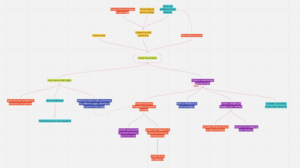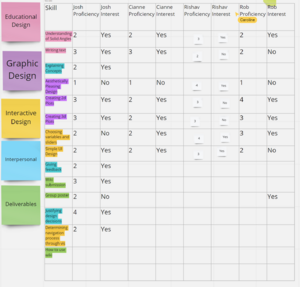Difference between revisions of "Tasks Tree"
(Created page with "The tasks tree or skills matrix should be your group's current best idea of the tasks which need to be completed. The tasks tree should be updated continuously throughout the...") |
|||
| (4 intermediate revisions by 2 users not shown) | |||
| Line 1: | Line 1: | ||
The tasks tree | The tasks tree should be your group's current best idea of the tasks which need to be completed. The tasks tree should be updated continuously throughout the project as you dig into tasks more and get a more specific idea of what needs to be done. Additionally, the tasks tree should be colour coded to allow tasks to be assigned to different team members. | ||
[[File:Initial tasks tree.png|thumb|An example of a first draft task tree.]] | [[File:Initial tasks tree.png|thumb|An example of a first draft task tree.]] | ||
An example of an initial task tree is shown. | An example of an initial task tree is shown. | ||
== Skills Matrix == | |||
[[File:ExampleSkillsMatrix.png|thumb|An example of an incomplete skills matrix.]] | |||
During the project work weeks (week 6 onwards), you will each take on individual responsibilities within your project team. This should be decided by considering everything that needs to be done - refer to your tasks tree for this - as well as each project partner's existing skills and interests,. | |||
The recommended way of doing this is by creating a skills matrix: list all areas of work that need to be done - again, you can refer to your tasks tree - and ask each project partner to note down their confidence in their existing skills in this area as well as their level of interest. | |||
Once you have completed the skills tree, you will need to discuss who will take on which tasks - bear in mind that interests may not always align with existing skills, e.g. somebody may not know much in a certain area yet but would love to learn more about it and take on responsibility for it! However, if all project partners ignore their existing skills you will not work very effectively, so aim to strike a balance. | |||
An example of an (incomplete) skills matrix is shown to the right. | |||
== Personal learning goals == | |||
In conjunction with dividing up the responsibilities in the project, each project partner should define their personal learning goals. This is what you wish to learn through working on this project. Your personal learning goals should align with the skills matrix: areas that you are interested in but do not have much experience in would make excellent personal learning goals. | |||
Don't forget to add in interpersonal skills as well: at the very least you should include a goal on learning to work in partnership with students and staff. | |||
== Examples from demo design project == | |||
Have a look at [https://miro.com/app/board/o9J_ls7JFEY=/?invite_link_id=459778164334 this Miro board] which shows examples of a task tree, skills matrix and set of personal learning goals, with accompanying advice written by students on how to create them. | |||
[[Category:iExplore Module]] | |||
Latest revision as of 16:30, 6 October 2021
The tasks tree should be your group's current best idea of the tasks which need to be completed. The tasks tree should be updated continuously throughout the project as you dig into tasks more and get a more specific idea of what needs to be done. Additionally, the tasks tree should be colour coded to allow tasks to be assigned to different team members.
An example of an initial task tree is shown.
Skills Matrix
During the project work weeks (week 6 onwards), you will each take on individual responsibilities within your project team. This should be decided by considering everything that needs to be done - refer to your tasks tree for this - as well as each project partner's existing skills and interests,.
The recommended way of doing this is by creating a skills matrix: list all areas of work that need to be done - again, you can refer to your tasks tree - and ask each project partner to note down their confidence in their existing skills in this area as well as their level of interest.
Once you have completed the skills tree, you will need to discuss who will take on which tasks - bear in mind that interests may not always align with existing skills, e.g. somebody may not know much in a certain area yet but would love to learn more about it and take on responsibility for it! However, if all project partners ignore their existing skills you will not work very effectively, so aim to strike a balance.
An example of an (incomplete) skills matrix is shown to the right.
Personal learning goals
In conjunction with dividing up the responsibilities in the project, each project partner should define their personal learning goals. This is what you wish to learn through working on this project. Your personal learning goals should align with the skills matrix: areas that you are interested in but do not have much experience in would make excellent personal learning goals.
Don't forget to add in interpersonal skills as well: at the very least you should include a goal on learning to work in partnership with students and staff.
Examples from demo design project
Have a look at this Miro board which shows examples of a task tree, skills matrix and set of personal learning goals, with accompanying advice written by students on how to create them.

